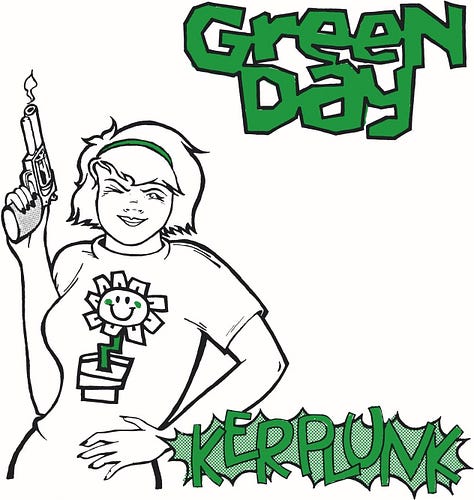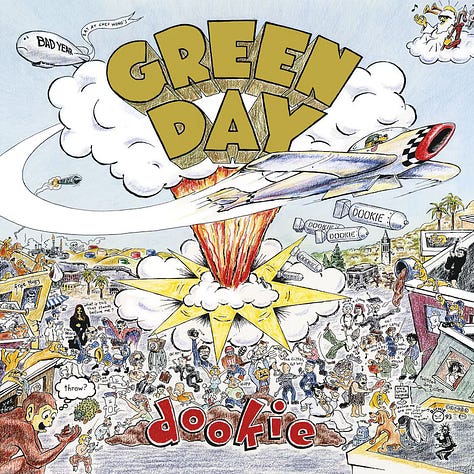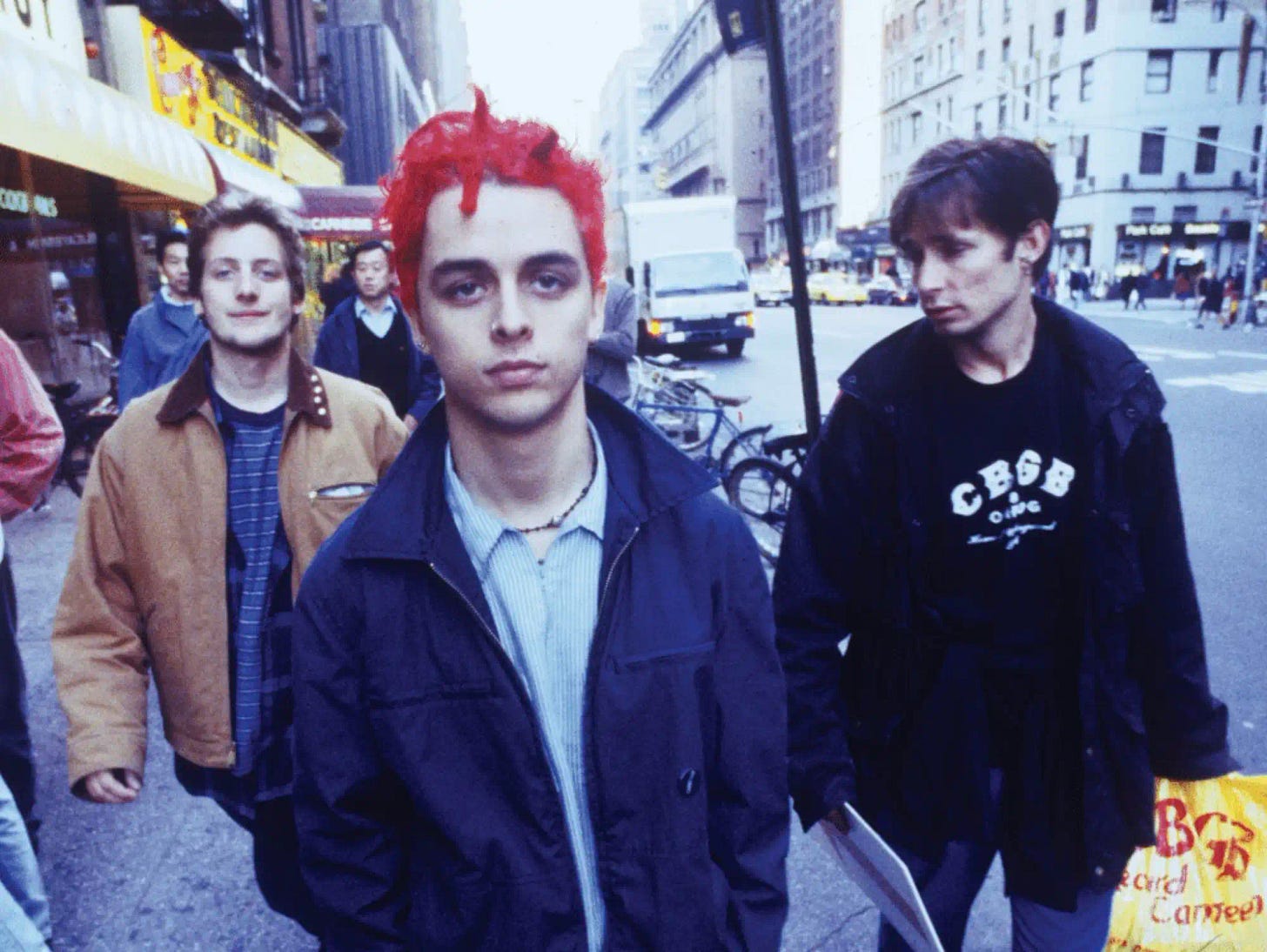Twenty-five years ago, I took my younger brother to a Green Day concert. It was a festival, actually, but Green Day were the headliners and the only reason for me blagging the media pass that got us in. I was still a teenager myself, and my brother six years younger than me, and I quickly regretted bringing him after we fell into the anarchic swirls of the mosh-pit. He’s much bigger and tougher than me these days, but back then I thought there was a good chance he’d be fatally swallowed by the crowd.
Green Day were an obsession for me in earlier adolescence, and the reason for bleaching my hair and learning some power chords. During one high school sports carnival, I spent most of the day drinking port from my water bottle and singing their songs with our school’s resident stoner who’d brought his guitar. Later, I drunkenly disgraced myself in the 800m relay.
(Around this time, I had two cherished and well-worn VHS tapes: of their ‘94 “Jaded in Chicago” concert, and their chaotic ‘98 appearance on ABC’s live Recovery program in which they arrived like jet-lagged tornadoes, sabotaged the interview, then hijacked the house band’s gear. After their profane and impromptu performance, host Dylan Lewis sardonically cursed the behaviour of punks and wondered if there’d be another episode. It’s a classic moment of live Australian television, and unrepeatable.)
The funny thing is: all this was only three or four years before the 2000 show, where I suddenly felt too old and too cool for the band. Having soundtracked so much of high school, my passion had abruptly chilled. It never really recovered, though today I can respect the melodic genius of Billie Joe Armstrong and the power of Tré Cool’s drumming and occasionally I might put on one of those earlier albums – the only ones I really know – the ones released between 1990 and 1997 when their weed gags could still make me giggle. And you know what? On listening now to those first three albums I reckon they made two-and-half-minute pop-punk jams that were better than their beloved forebears, the Stiff Little Fingers and Buzzcocks.
In 2000, Green Day were touring Warning, an album that sounded like a band that had badly run out of steam. They were all married fathers by now (or divorced dads, as was the case with their jester drummer) and the brattishness they’d lost was yet to be replaced by politics. Warning was insipid, and a commercial failure, and critics assumed it was their final whimper: the album title’s real significance, in other words, applied to the creatively exhausted band itself.
As was already traditional by then, the band closed that 2000 show with a solo Billie Joe singing their sappy acoustic ballad “Good Riddance (Time of Your Life)” – albeit with his Fernandes “Stratocaster”. But there was also an unauthorised and quickly uncontrolled pyrotechnic display to go with it.
Just before Tré Cool left the stage, he removed a lighter and set fire to his drum kit – a common stunt for the band. But the fire quickly spread to the giant “Green Day” banner that hung behind them. Made from some type of highly flammable plastic, the banner went up quickly, leaving a perfectly nonchalant Billie Joe to perform against a great wall of flame while panicked security staff ran about unsure of what to do and whether they should pull Billie Joe, mid-song, from the stage and enforce a mass evacuation.
They let him play. And while the final track was just a solo ballad, the uncontrolled fire and its thick black smoke only further inspired the crowd’s hysteria which, in turn, intensified my anxiety about my little brother.
*



Things changed. Having flirted with dissolution, the group began writing differently – not just lyrically, but in their collaborations with each other. Warning proved to be a lame interstitial in their career, rather than its obituary.
Having outgrown their scatology and bedroom nihilism, but not their chord progressions, Green Day found revival in politics – and with 2004’s American Idiot, their first explicitly political album, Billie Joe was snarling about George W. Bush and a nation stupefied by corporate media.
They now sang about generational disillusionment rather than their own, and perhaps their starkest change was suggested by the album’s title: where they once revelled in their own idiocy, they now offered themselves as punk rebels against a supposed corporate/political conspiracy to encourage mass docility. This is boilerplate stuff, but it was still a long way from songs about wanking. Billie Joe now thought of himself more like Joe Strummer than a bratty solipsist.
But it was the bratty solipsists that I enjoyed most – and enjoyed most ardently when I was one too.
*
To be honest, this short essay is merely an excuse to share a trivial and contestable observation about the band’s popularity. In 2005, while an Honours student, I earned some modest coin tutoring high-school students. At the home of one, I noticed the Green Day logo she’d drawn on her pencil case – much as I had ten years before. It struck me then as unusual: tiny proof that while the band had aged, their fans had not.
I still think that. Without any data to support this, it seems to me that Green Day are almost unique in their longevity for having retained – for 35 years now – fans of the same average age. If we take two bands that formed at roughly the same time as Green Day, and who I’ve seen play in the past year – Ride and Teenage Fanclub – well, judging by the audience for each show, I saw fans who’ve clearly aged with the band. They’re the same folks who bought their albums in the early Nineties, and whose hair loss has matched their heroes’.
Conversely, I don’t think Green Day fans have, as a rule, aged with the band – rather, the band has some rare gift for perpetually attracting adolescent fans, even as the group find themselves in their mid-fifties (all three were born in 1972). It must help that Billie Joe looks 35, and that they perform with the same manic intensity I saw 25 years ago. But, still: these bratty pop-punks were inducted into the Rock ‘n’ Roll Hall of Fame a decade ago. They’re not just veterans – they’re now veteran inductees of rock’s mausoleum.
Now, maybe I’m wrong – and I’d love to hear from you if I am. And if I’m not wrong, I regret to tell you that I have no theory to explain the unusual demographic permanence of their fans.
But I humbly suggest that today, the artists that might be sung raucously at high school parties and drawn upon pencil cases, are artists formed in recent times and who aren’t much older than their typical fan. Green Day, I think, are an outlier to this – and have been for almost four decades. This, to me, constitutes a phenomenon worthy of investigation.
It seems possible to me that Neil Young might be a slightly comparable phenomenon – that is, a still working veteran artist (at 79, he’s still very busy) for whom subsequent generations will continually and enthusiastically discover. His run between 1969 and 1979 is astonishing – prolific and consistently awesome – but his ‘90s renaissance (two albums from this decade, Ragged Glory and Harvest Moon, are two of my favourites) was also assisted by the public feting of younger bands like Nirvana and Pearl Jam: the latter would record an album with him; Kurt Cobain would cite Young’s lyrics in his suicide note (an act of tribute, but unwittingly cruel).
There was also an MTV Unplugged appearance that decade, which helped stir the interests of those born after Buffalo Springfield had broken up, and helpful too was the media’s sticky designation for Young as “The Godfather of Grunge”.
Undoubtedly Young’s music endures, and so does he – putting aside the constant stream of archival releases, he’s released six albums in the past decade – but would the average age of his audience today be in the low twenties? No way. I’d wager it would span several generations.
But, hey: none of this matters. These are idle thoughts, offered without judgement or sophistication. And God forbid I descend into grumpy middle-aged condescension and/or nostalgia. Those Green Day boys did good, each of them borne of hard or peculiar childhoods, and possessed only of passion, brashness and a few power chords, they sold almost 100 million records. Good on them. My passion may have long dwindled, but plenty others replaced it.
But, dear reader: am I right? And, if so, are there other examples of Peter Pan fandom?





